Supporting the Individual Journey through Integrated Health and Social Care (pdf)
VerifiedAdded on 2021/02/19
|15
|4993
|159
AI Summary
Contribute Materials
Your contribution can guide someone’s learning journey. Share your
documents today.
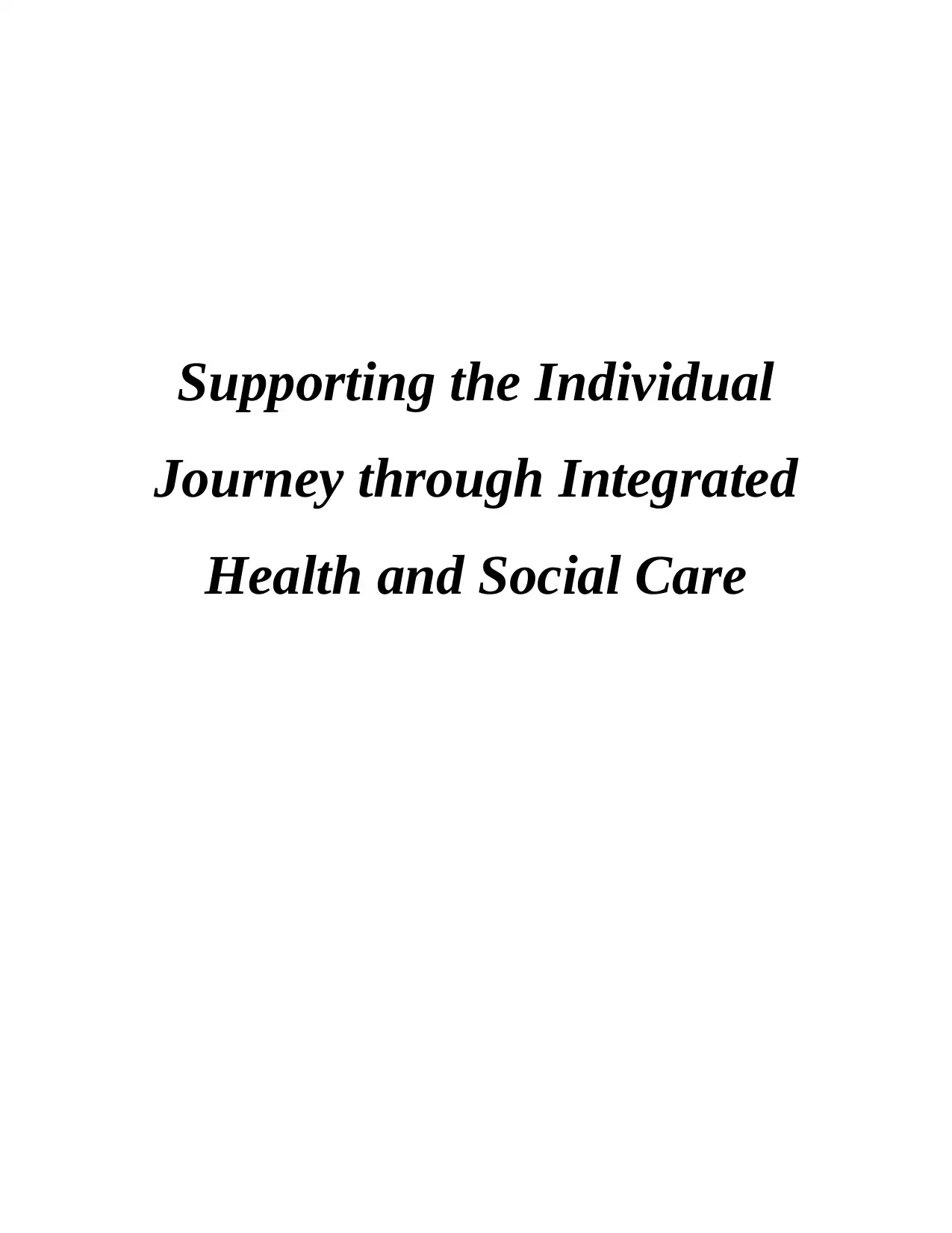
Supporting the Individual
Journey through Integrated
Health and Social Care
Journey through Integrated
Health and Social Care
Secure Best Marks with AI Grader
Need help grading? Try our AI Grader for instant feedback on your assignments.
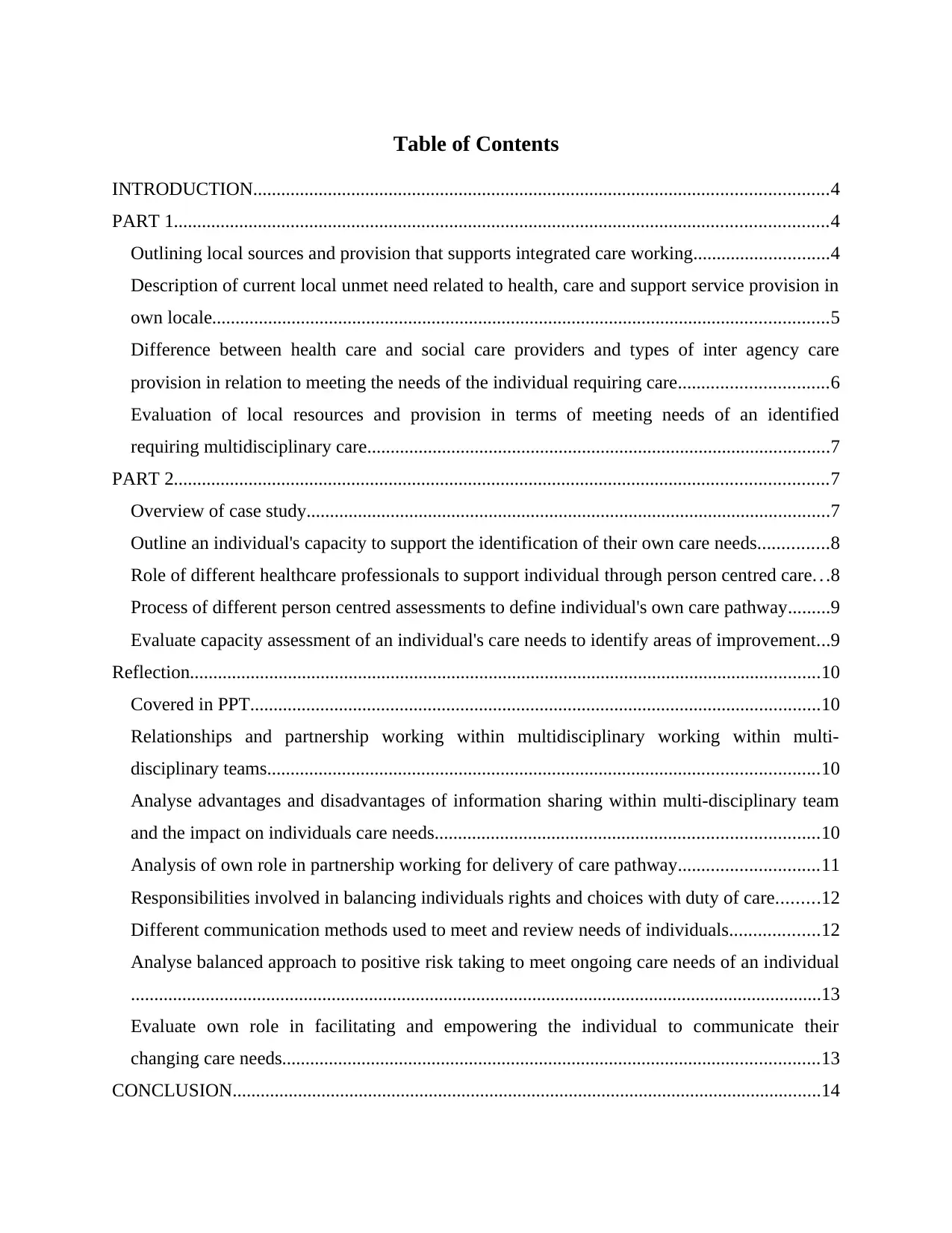
Table of Contents
INTRODUCTION...........................................................................................................................4
PART 1............................................................................................................................................4
Outlining local sources and provision that supports integrated care working.............................4
Description of current local unmet need related to health, care and support service provision in
own locale....................................................................................................................................5
Difference between health care and social care providers and types of inter agency care
provision in relation to meeting the needs of the individual requiring care................................6
Evaluation of local resources and provision in terms of meeting needs of an identified
requiring multidisciplinary care...................................................................................................7
PART 2............................................................................................................................................7
Overview of case study................................................................................................................7
Outline an individual's capacity to support the identification of their own care needs...............8
Role of different healthcare professionals to support individual through person centred care. . .8
Process of different person centred assessments to define individual's own care pathway.........9
Evaluate capacity assessment of an individual's care needs to identify areas of improvement...9
Reflection.......................................................................................................................................10
Covered in PPT..........................................................................................................................10
Relationships and partnership working within multidisciplinary working within multi-
disciplinary teams......................................................................................................................10
Analyse advantages and disadvantages of information sharing within multi-disciplinary team
and the impact on individuals care needs..................................................................................10
Analysis of own role in partnership working for delivery of care pathway..............................11
Responsibilities involved in balancing individuals rights and choices with duty of care.........12
Different communication methods used to meet and review needs of individuals...................12
Analyse balanced approach to positive risk taking to meet ongoing care needs of an individual
....................................................................................................................................................13
Evaluate own role in facilitating and empowering the individual to communicate their
changing care needs...................................................................................................................13
CONCLUSION..............................................................................................................................14
INTRODUCTION...........................................................................................................................4
PART 1............................................................................................................................................4
Outlining local sources and provision that supports integrated care working.............................4
Description of current local unmet need related to health, care and support service provision in
own locale....................................................................................................................................5
Difference between health care and social care providers and types of inter agency care
provision in relation to meeting the needs of the individual requiring care................................6
Evaluation of local resources and provision in terms of meeting needs of an identified
requiring multidisciplinary care...................................................................................................7
PART 2............................................................................................................................................7
Overview of case study................................................................................................................7
Outline an individual's capacity to support the identification of their own care needs...............8
Role of different healthcare professionals to support individual through person centred care. . .8
Process of different person centred assessments to define individual's own care pathway.........9
Evaluate capacity assessment of an individual's care needs to identify areas of improvement...9
Reflection.......................................................................................................................................10
Covered in PPT..........................................................................................................................10
Relationships and partnership working within multidisciplinary working within multi-
disciplinary teams......................................................................................................................10
Analyse advantages and disadvantages of information sharing within multi-disciplinary team
and the impact on individuals care needs..................................................................................10
Analysis of own role in partnership working for delivery of care pathway..............................11
Responsibilities involved in balancing individuals rights and choices with duty of care.........12
Different communication methods used to meet and review needs of individuals...................12
Analyse balanced approach to positive risk taking to meet ongoing care needs of an individual
....................................................................................................................................................13
Evaluate own role in facilitating and empowering the individual to communicate their
changing care needs...................................................................................................................13
CONCLUSION..............................................................................................................................14

REFERENCES..............................................................................................................................15
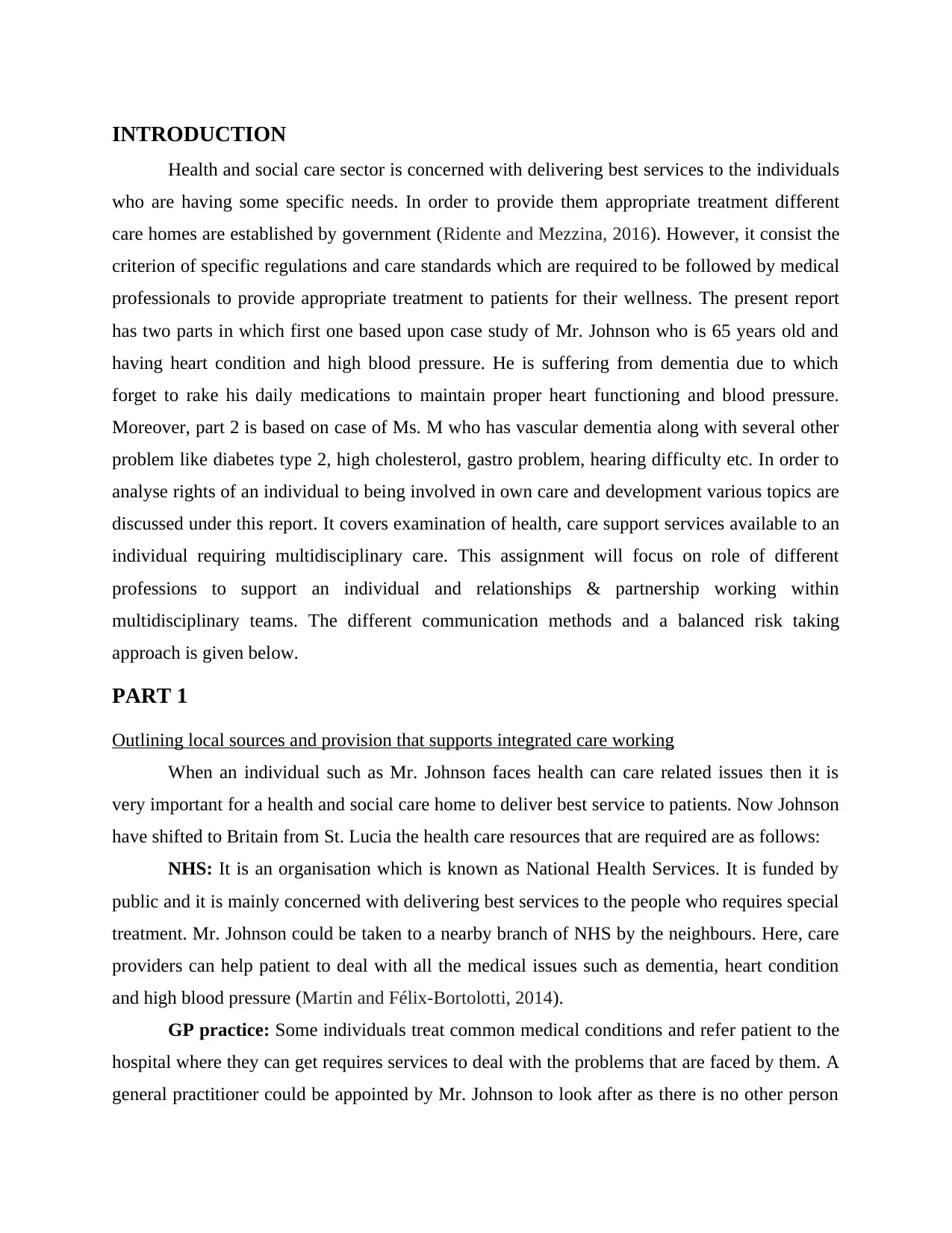
INTRODUCTION
Health and social care sector is concerned with delivering best services to the individuals
who are having some specific needs. In order to provide them appropriate treatment different
care homes are established by government (Ridente and Mezzina, 2016). However, it consist the
criterion of specific regulations and care standards which are required to be followed by medical
professionals to provide appropriate treatment to patients for their wellness. The present report
has two parts in which first one based upon case study of Mr. Johnson who is 65 years old and
having heart condition and high blood pressure. He is suffering from dementia due to which
forget to rake his daily medications to maintain proper heart functioning and blood pressure.
Moreover, part 2 is based on case of Ms. M who has vascular dementia along with several other
problem like diabetes type 2, high cholesterol, gastro problem, hearing difficulty etc. In order to
analyse rights of an individual to being involved in own care and development various topics are
discussed under this report. It covers examination of health, care support services available to an
individual requiring multidisciplinary care. This assignment will focus on role of different
professions to support an individual and relationships & partnership working within
multidisciplinary teams. The different communication methods and a balanced risk taking
approach is given below.
PART 1
Outlining local sources and provision that supports integrated care working
When an individual such as Mr. Johnson faces health can care related issues then it is
very important for a health and social care home to deliver best service to patients. Now Johnson
have shifted to Britain from St. Lucia the health care resources that are required are as follows:
NHS: It is an organisation which is known as National Health Services. It is funded by
public and it is mainly concerned with delivering best services to the people who requires special
treatment. Mr. Johnson could be taken to a nearby branch of NHS by the neighbours. Here, care
providers can help patient to deal with all the medical issues such as dementia, heart condition
and high blood pressure (Martin and Félix‐Bortolotti, 2014).
GP practice: Some individuals treat common medical conditions and refer patient to the
hospital where they can get requires services to deal with the problems that are faced by them. A
general practitioner could be appointed by Mr. Johnson to look after as there is no other person
Health and social care sector is concerned with delivering best services to the individuals
who are having some specific needs. In order to provide them appropriate treatment different
care homes are established by government (Ridente and Mezzina, 2016). However, it consist the
criterion of specific regulations and care standards which are required to be followed by medical
professionals to provide appropriate treatment to patients for their wellness. The present report
has two parts in which first one based upon case study of Mr. Johnson who is 65 years old and
having heart condition and high blood pressure. He is suffering from dementia due to which
forget to rake his daily medications to maintain proper heart functioning and blood pressure.
Moreover, part 2 is based on case of Ms. M who has vascular dementia along with several other
problem like diabetes type 2, high cholesterol, gastro problem, hearing difficulty etc. In order to
analyse rights of an individual to being involved in own care and development various topics are
discussed under this report. It covers examination of health, care support services available to an
individual requiring multidisciplinary care. This assignment will focus on role of different
professions to support an individual and relationships & partnership working within
multidisciplinary teams. The different communication methods and a balanced risk taking
approach is given below.
PART 1
Outlining local sources and provision that supports integrated care working
When an individual such as Mr. Johnson faces health can care related issues then it is
very important for a health and social care home to deliver best service to patients. Now Johnson
have shifted to Britain from St. Lucia the health care resources that are required are as follows:
NHS: It is an organisation which is known as National Health Services. It is funded by
public and it is mainly concerned with delivering best services to the people who requires special
treatment. Mr. Johnson could be taken to a nearby branch of NHS by the neighbours. Here, care
providers can help patient to deal with all the medical issues such as dementia, heart condition
and high blood pressure (Martin and Félix‐Bortolotti, 2014).
GP practice: Some individuals treat common medical conditions and refer patient to the
hospital where they can get requires services to deal with the problems that are faced by them. A
general practitioner could be appointed by Mr. Johnson to look after as there is no other person
Secure Best Marks with AI Grader
Need help grading? Try our AI Grader for instant feedback on your assignments.
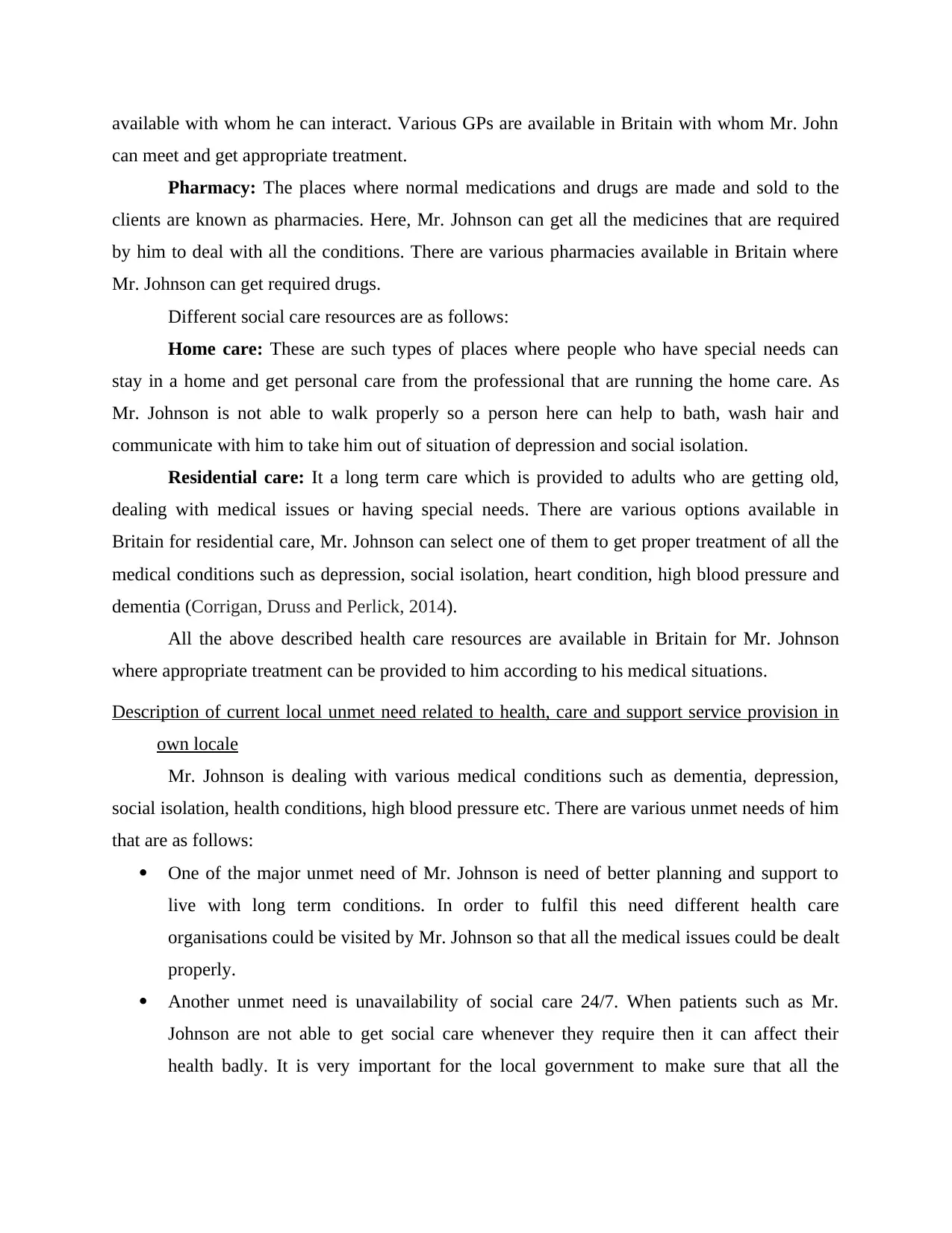
available with whom he can interact. Various GPs are available in Britain with whom Mr. John
can meet and get appropriate treatment.
Pharmacy: The places where normal medications and drugs are made and sold to the
clients are known as pharmacies. Here, Mr. Johnson can get all the medicines that are required
by him to deal with all the conditions. There are various pharmacies available in Britain where
Mr. Johnson can get required drugs.
Different social care resources are as follows:
Home care: These are such types of places where people who have special needs can
stay in a home and get personal care from the professional that are running the home care. As
Mr. Johnson is not able to walk properly so a person here can help to bath, wash hair and
communicate with him to take him out of situation of depression and social isolation.
Residential care: It a long term care which is provided to adults who are getting old,
dealing with medical issues or having special needs. There are various options available in
Britain for residential care, Mr. Johnson can select one of them to get proper treatment of all the
medical conditions such as depression, social isolation, heart condition, high blood pressure and
dementia (Corrigan, Druss and Perlick, 2014).
All the above described health care resources are available in Britain for Mr. Johnson
where appropriate treatment can be provided to him according to his medical situations.
Description of current local unmet need related to health, care and support service provision in
own locale
Mr. Johnson is dealing with various medical conditions such as dementia, depression,
social isolation, health conditions, high blood pressure etc. There are various unmet needs of him
that are as follows:
One of the major unmet need of Mr. Johnson is need of better planning and support to
live with long term conditions. In order to fulfil this need different health care
organisations could be visited by Mr. Johnson so that all the medical issues could be dealt
properly.
Another unmet need is unavailability of social care 24/7. When patients such as Mr.
Johnson are not able to get social care whenever they require then it can affect their
health badly. It is very important for the local government to make sure that all the
can meet and get appropriate treatment.
Pharmacy: The places where normal medications and drugs are made and sold to the
clients are known as pharmacies. Here, Mr. Johnson can get all the medicines that are required
by him to deal with all the conditions. There are various pharmacies available in Britain where
Mr. Johnson can get required drugs.
Different social care resources are as follows:
Home care: These are such types of places where people who have special needs can
stay in a home and get personal care from the professional that are running the home care. As
Mr. Johnson is not able to walk properly so a person here can help to bath, wash hair and
communicate with him to take him out of situation of depression and social isolation.
Residential care: It a long term care which is provided to adults who are getting old,
dealing with medical issues or having special needs. There are various options available in
Britain for residential care, Mr. Johnson can select one of them to get proper treatment of all the
medical conditions such as depression, social isolation, heart condition, high blood pressure and
dementia (Corrigan, Druss and Perlick, 2014).
All the above described health care resources are available in Britain for Mr. Johnson
where appropriate treatment can be provided to him according to his medical situations.
Description of current local unmet need related to health, care and support service provision in
own locale
Mr. Johnson is dealing with various medical conditions such as dementia, depression,
social isolation, health conditions, high blood pressure etc. There are various unmet needs of him
that are as follows:
One of the major unmet need of Mr. Johnson is need of better planning and support to
live with long term conditions. In order to fulfil this need different health care
organisations could be visited by Mr. Johnson so that all the medical issues could be dealt
properly.
Another unmet need is unavailability of social care 24/7. When patients such as Mr.
Johnson are not able to get social care whenever they require then it can affect their
health badly. It is very important for the local government to make sure that all the
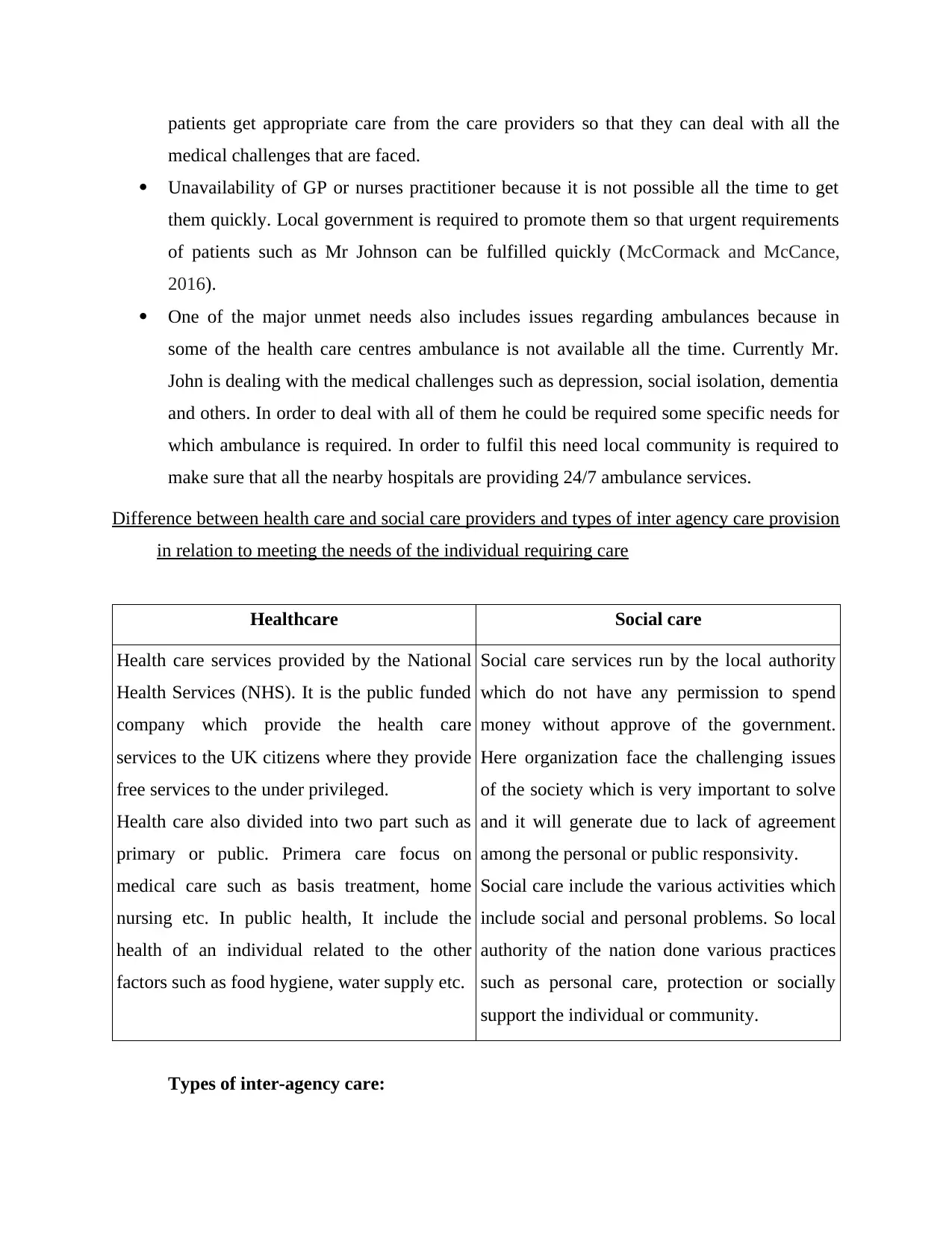
patients get appropriate care from the care providers so that they can deal with all the
medical challenges that are faced.
Unavailability of GP or nurses practitioner because it is not possible all the time to get
them quickly. Local government is required to promote them so that urgent requirements
of patients such as Mr Johnson can be fulfilled quickly (McCormack and McCance,
2016).
One of the major unmet needs also includes issues regarding ambulances because in
some of the health care centres ambulance is not available all the time. Currently Mr.
John is dealing with the medical challenges such as depression, social isolation, dementia
and others. In order to deal with all of them he could be required some specific needs for
which ambulance is required. In order to fulfil this need local community is required to
make sure that all the nearby hospitals are providing 24/7 ambulance services.
Difference between health care and social care providers and types of inter agency care provision
in relation to meeting the needs of the individual requiring care
Healthcare Social care
Health care services provided by the National
Health Services (NHS). It is the public funded
company which provide the health care
services to the UK citizens where they provide
free services to the under privileged.
Health care also divided into two part such as
primary or public. Primera care focus on
medical care such as basis treatment, home
nursing etc. In public health, It include the
health of an individual related to the other
factors such as food hygiene, water supply etc.
Social care services run by the local authority
which do not have any permission to spend
money without approve of the government.
Here organization face the challenging issues
of the society which is very important to solve
and it will generate due to lack of agreement
among the personal or public responsivity.
Social care include the various activities which
include social and personal problems. So local
authority of the nation done various practices
such as personal care, protection or socially
support the individual or community.
Types of inter-agency care:
medical challenges that are faced.
Unavailability of GP or nurses practitioner because it is not possible all the time to get
them quickly. Local government is required to promote them so that urgent requirements
of patients such as Mr Johnson can be fulfilled quickly (McCormack and McCance,
2016).
One of the major unmet needs also includes issues regarding ambulances because in
some of the health care centres ambulance is not available all the time. Currently Mr.
John is dealing with the medical challenges such as depression, social isolation, dementia
and others. In order to deal with all of them he could be required some specific needs for
which ambulance is required. In order to fulfil this need local community is required to
make sure that all the nearby hospitals are providing 24/7 ambulance services.
Difference between health care and social care providers and types of inter agency care provision
in relation to meeting the needs of the individual requiring care
Healthcare Social care
Health care services provided by the National
Health Services (NHS). It is the public funded
company which provide the health care
services to the UK citizens where they provide
free services to the under privileged.
Health care also divided into two part such as
primary or public. Primera care focus on
medical care such as basis treatment, home
nursing etc. In public health, It include the
health of an individual related to the other
factors such as food hygiene, water supply etc.
Social care services run by the local authority
which do not have any permission to spend
money without approve of the government.
Here organization face the challenging issues
of the society which is very important to solve
and it will generate due to lack of agreement
among the personal or public responsivity.
Social care include the various activities which
include social and personal problems. So local
authority of the nation done various practices
such as personal care, protection or socially
support the individual or community.
Types of inter-agency care:
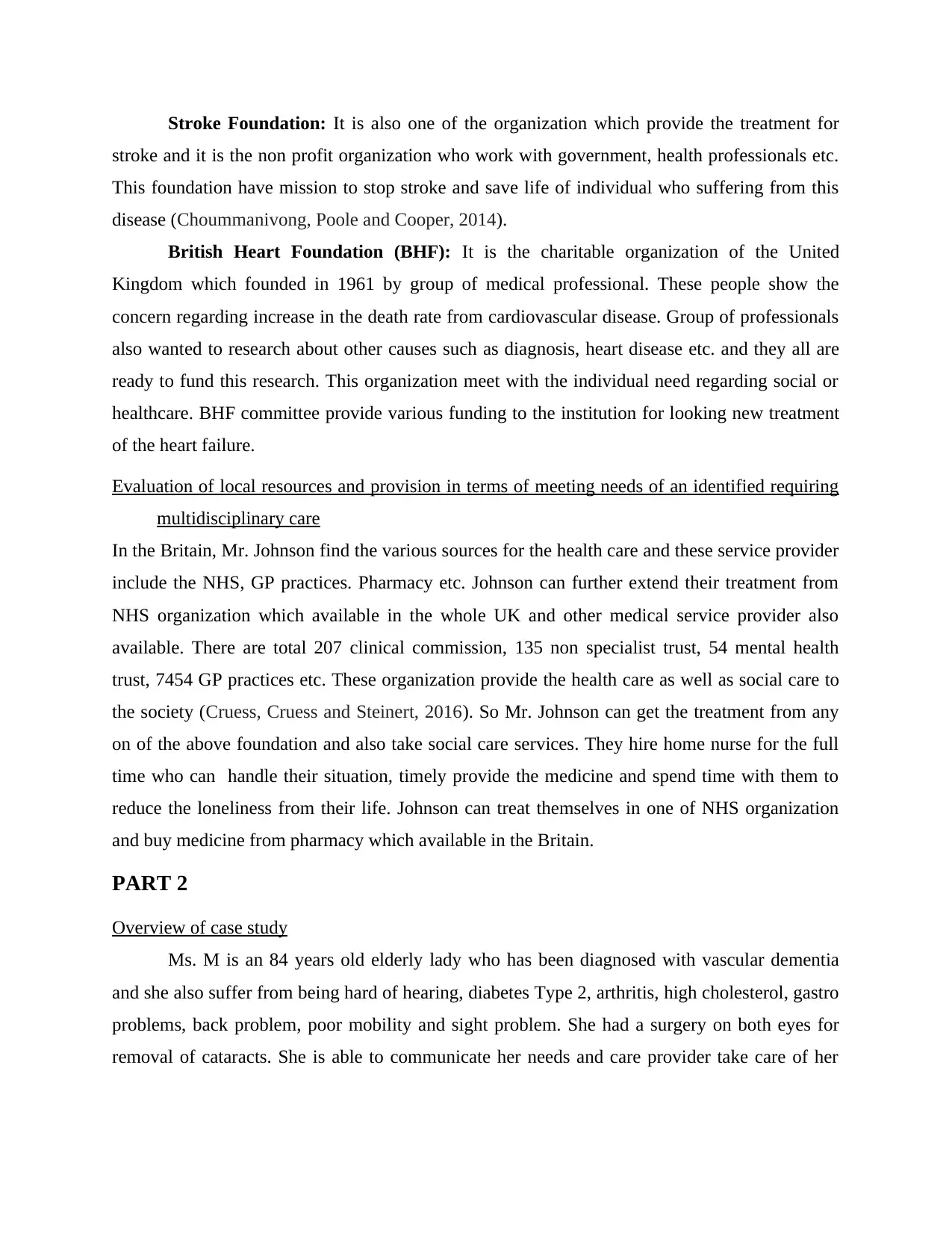
Stroke Foundation: It is also one of the organization which provide the treatment for
stroke and it is the non profit organization who work with government, health professionals etc.
This foundation have mission to stop stroke and save life of individual who suffering from this
disease (Choummanivong, Poole and Cooper, 2014).
British Heart Foundation (BHF): It is the charitable organization of the United
Kingdom which founded in 1961 by group of medical professional. These people show the
concern regarding increase in the death rate from cardiovascular disease. Group of professionals
also wanted to research about other causes such as diagnosis, heart disease etc. and they all are
ready to fund this research. This organization meet with the individual need regarding social or
healthcare. BHF committee provide various funding to the institution for looking new treatment
of the heart failure.
Evaluation of local resources and provision in terms of meeting needs of an identified requiring
multidisciplinary care
In the Britain, Mr. Johnson find the various sources for the health care and these service provider
include the NHS, GP practices. Pharmacy etc. Johnson can further extend their treatment from
NHS organization which available in the whole UK and other medical service provider also
available. There are total 207 clinical commission, 135 non specialist trust, 54 mental health
trust, 7454 GP practices etc. These organization provide the health care as well as social care to
the society (Cruess, Cruess and Steinert, 2016). So Mr. Johnson can get the treatment from any
on of the above foundation and also take social care services. They hire home nurse for the full
time who can handle their situation, timely provide the medicine and spend time with them to
reduce the loneliness from their life. Johnson can treat themselves in one of NHS organization
and buy medicine from pharmacy which available in the Britain.
PART 2
Overview of case study
Ms. M is an 84 years old elderly lady who has been diagnosed with vascular dementia
and she also suffer from being hard of hearing, diabetes Type 2, arthritis, high cholesterol, gastro
problems, back problem, poor mobility and sight problem. She had a surgery on both eyes for
removal of cataracts. She is able to communicate her needs and care provider take care of her
stroke and it is the non profit organization who work with government, health professionals etc.
This foundation have mission to stop stroke and save life of individual who suffering from this
disease (Choummanivong, Poole and Cooper, 2014).
British Heart Foundation (BHF): It is the charitable organization of the United
Kingdom which founded in 1961 by group of medical professional. These people show the
concern regarding increase in the death rate from cardiovascular disease. Group of professionals
also wanted to research about other causes such as diagnosis, heart disease etc. and they all are
ready to fund this research. This organization meet with the individual need regarding social or
healthcare. BHF committee provide various funding to the institution for looking new treatment
of the heart failure.
Evaluation of local resources and provision in terms of meeting needs of an identified requiring
multidisciplinary care
In the Britain, Mr. Johnson find the various sources for the health care and these service provider
include the NHS, GP practices. Pharmacy etc. Johnson can further extend their treatment from
NHS organization which available in the whole UK and other medical service provider also
available. There are total 207 clinical commission, 135 non specialist trust, 54 mental health
trust, 7454 GP practices etc. These organization provide the health care as well as social care to
the society (Cruess, Cruess and Steinert, 2016). So Mr. Johnson can get the treatment from any
on of the above foundation and also take social care services. They hire home nurse for the full
time who can handle their situation, timely provide the medicine and spend time with them to
reduce the loneliness from their life. Johnson can treat themselves in one of NHS organization
and buy medicine from pharmacy which available in the Britain.
PART 2
Overview of case study
Ms. M is an 84 years old elderly lady who has been diagnosed with vascular dementia
and she also suffer from being hard of hearing, diabetes Type 2, arthritis, high cholesterol, gastro
problems, back problem, poor mobility and sight problem. She had a surgery on both eyes for
removal of cataracts. She is able to communicate her needs and care provider take care of her
Paraphrase This Document
Need a fresh take? Get an instant paraphrase of this document with our AI Paraphraser
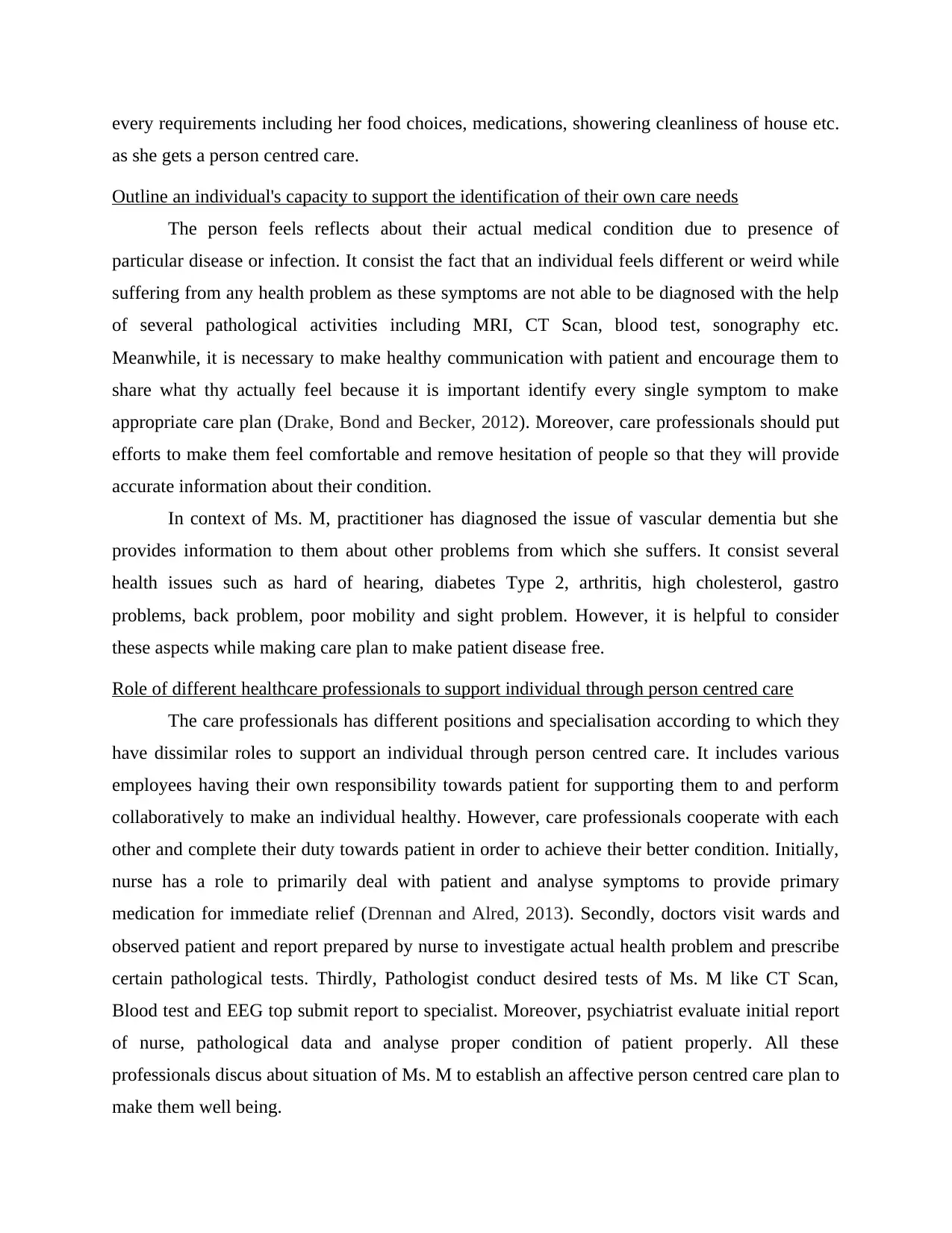
every requirements including her food choices, medications, showering cleanliness of house etc.
as she gets a person centred care.
Outline an individual's capacity to support the identification of their own care needs
The person feels reflects about their actual medical condition due to presence of
particular disease or infection. It consist the fact that an individual feels different or weird while
suffering from any health problem as these symptoms are not able to be diagnosed with the help
of several pathological activities including MRI, CT Scan, blood test, sonography etc.
Meanwhile, it is necessary to make healthy communication with patient and encourage them to
share what thy actually feel because it is important identify every single symptom to make
appropriate care plan (Drake, Bond and Becker, 2012). Moreover, care professionals should put
efforts to make them feel comfortable and remove hesitation of people so that they will provide
accurate information about their condition.
In context of Ms. M, practitioner has diagnosed the issue of vascular dementia but she
provides information to them about other problems from which she suffers. It consist several
health issues such as hard of hearing, diabetes Type 2, arthritis, high cholesterol, gastro
problems, back problem, poor mobility and sight problem. However, it is helpful to consider
these aspects while making care plan to make patient disease free.
Role of different healthcare professionals to support individual through person centred care
The care professionals has different positions and specialisation according to which they
have dissimilar roles to support an individual through person centred care. It includes various
employees having their own responsibility towards patient for supporting them to and perform
collaboratively to make an individual healthy. However, care professionals cooperate with each
other and complete their duty towards patient in order to achieve their better condition. Initially,
nurse has a role to primarily deal with patient and analyse symptoms to provide primary
medication for immediate relief (Drennan and Alred, 2013). Secondly, doctors visit wards and
observed patient and report prepared by nurse to investigate actual health problem and prescribe
certain pathological tests. Thirdly, Pathologist conduct desired tests of Ms. M like CT Scan,
Blood test and EEG top submit report to specialist. Moreover, psychiatrist evaluate initial report
of nurse, pathological data and analyse proper condition of patient properly. All these
professionals discus about situation of Ms. M to establish an affective person centred care plan to
make them well being.
as she gets a person centred care.
Outline an individual's capacity to support the identification of their own care needs
The person feels reflects about their actual medical condition due to presence of
particular disease or infection. It consist the fact that an individual feels different or weird while
suffering from any health problem as these symptoms are not able to be diagnosed with the help
of several pathological activities including MRI, CT Scan, blood test, sonography etc.
Meanwhile, it is necessary to make healthy communication with patient and encourage them to
share what thy actually feel because it is important identify every single symptom to make
appropriate care plan (Drake, Bond and Becker, 2012). Moreover, care professionals should put
efforts to make them feel comfortable and remove hesitation of people so that they will provide
accurate information about their condition.
In context of Ms. M, practitioner has diagnosed the issue of vascular dementia but she
provides information to them about other problems from which she suffers. It consist several
health issues such as hard of hearing, diabetes Type 2, arthritis, high cholesterol, gastro
problems, back problem, poor mobility and sight problem. However, it is helpful to consider
these aspects while making care plan to make patient disease free.
Role of different healthcare professionals to support individual through person centred care
The care professionals has different positions and specialisation according to which they
have dissimilar roles to support an individual through person centred care. It includes various
employees having their own responsibility towards patient for supporting them to and perform
collaboratively to make an individual healthy. However, care professionals cooperate with each
other and complete their duty towards patient in order to achieve their better condition. Initially,
nurse has a role to primarily deal with patient and analyse symptoms to provide primary
medication for immediate relief (Drennan and Alred, 2013). Secondly, doctors visit wards and
observed patient and report prepared by nurse to investigate actual health problem and prescribe
certain pathological tests. Thirdly, Pathologist conduct desired tests of Ms. M like CT Scan,
Blood test and EEG top submit report to specialist. Moreover, psychiatrist evaluate initial report
of nurse, pathological data and analyse proper condition of patient properly. All these
professionals discus about situation of Ms. M to establish an affective person centred care plan to
make them well being.
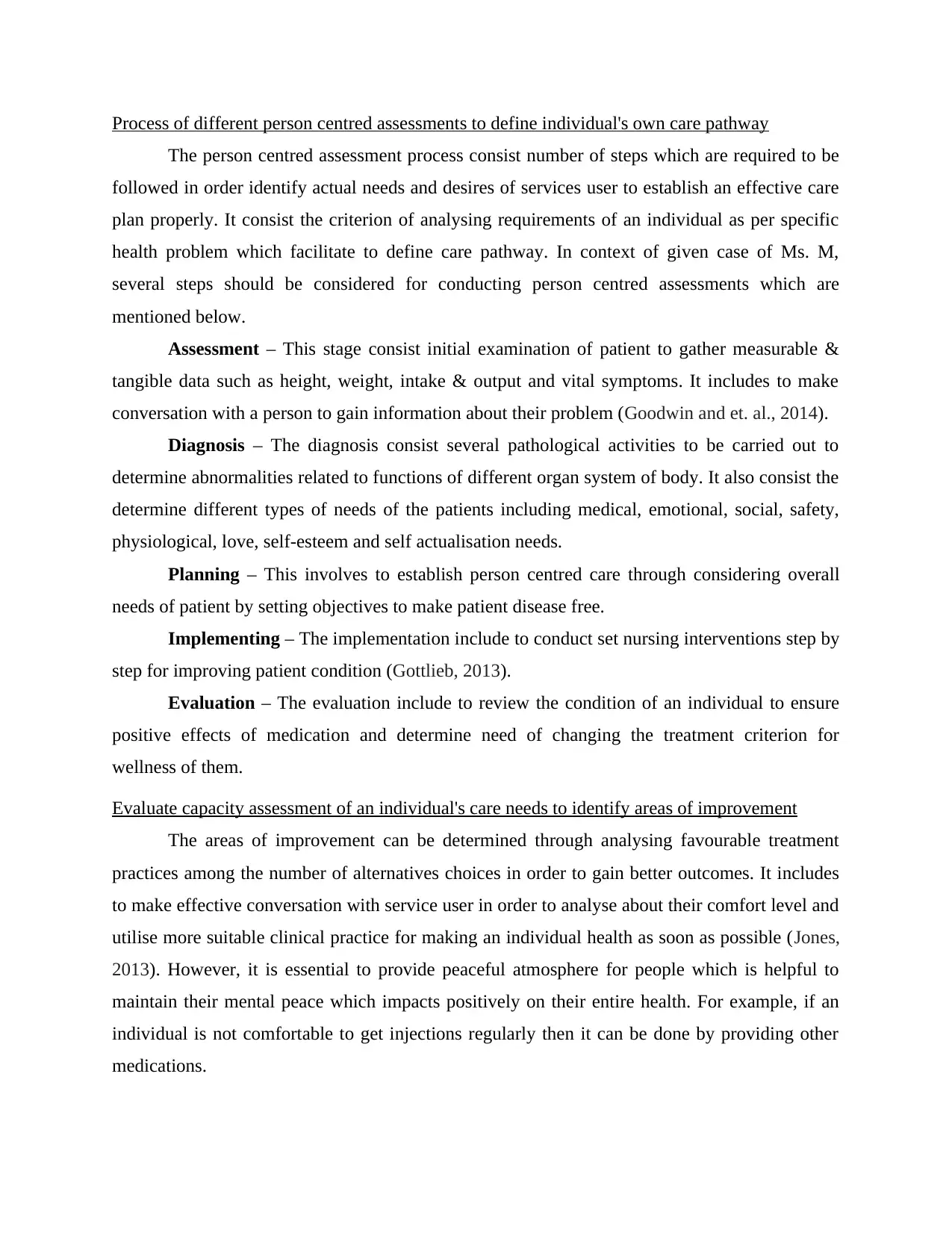
Process of different person centred assessments to define individual's own care pathway
The person centred assessment process consist number of steps which are required to be
followed in order identify actual needs and desires of services user to establish an effective care
plan properly. It consist the criterion of analysing requirements of an individual as per specific
health problem which facilitate to define care pathway. In context of given case of Ms. M,
several steps should be considered for conducting person centred assessments which are
mentioned below.
Assessment – This stage consist initial examination of patient to gather measurable &
tangible data such as height, weight, intake & output and vital symptoms. It includes to make
conversation with a person to gain information about their problem (Goodwin and et. al., 2014).
Diagnosis – The diagnosis consist several pathological activities to be carried out to
determine abnormalities related to functions of different organ system of body. It also consist the
determine different types of needs of the patients including medical, emotional, social, safety,
physiological, love, self-esteem and self actualisation needs.
Planning – This involves to establish person centred care through considering overall
needs of patient by setting objectives to make patient disease free.
Implementing – The implementation include to conduct set nursing interventions step by
step for improving patient condition (Gottlieb, 2013).
Evaluation – The evaluation include to review the condition of an individual to ensure
positive effects of medication and determine need of changing the treatment criterion for
wellness of them.
Evaluate capacity assessment of an individual's care needs to identify areas of improvement
The areas of improvement can be determined through analysing favourable treatment
practices among the number of alternatives choices in order to gain better outcomes. It includes
to make effective conversation with service user in order to analyse about their comfort level and
utilise more suitable clinical practice for making an individual health as soon as possible (Jones,
2013). However, it is essential to provide peaceful atmosphere for people which is helpful to
maintain their mental peace which impacts positively on their entire health. For example, if an
individual is not comfortable to get injections regularly then it can be done by providing other
medications.
The person centred assessment process consist number of steps which are required to be
followed in order identify actual needs and desires of services user to establish an effective care
plan properly. It consist the criterion of analysing requirements of an individual as per specific
health problem which facilitate to define care pathway. In context of given case of Ms. M,
several steps should be considered for conducting person centred assessments which are
mentioned below.
Assessment – This stage consist initial examination of patient to gather measurable &
tangible data such as height, weight, intake & output and vital symptoms. It includes to make
conversation with a person to gain information about their problem (Goodwin and et. al., 2014).
Diagnosis – The diagnosis consist several pathological activities to be carried out to
determine abnormalities related to functions of different organ system of body. It also consist the
determine different types of needs of the patients including medical, emotional, social, safety,
physiological, love, self-esteem and self actualisation needs.
Planning – This involves to establish person centred care through considering overall
needs of patient by setting objectives to make patient disease free.
Implementing – The implementation include to conduct set nursing interventions step by
step for improving patient condition (Gottlieb, 2013).
Evaluation – The evaluation include to review the condition of an individual to ensure
positive effects of medication and determine need of changing the treatment criterion for
wellness of them.
Evaluate capacity assessment of an individual's care needs to identify areas of improvement
The areas of improvement can be determined through analysing favourable treatment
practices among the number of alternatives choices in order to gain better outcomes. It includes
to make effective conversation with service user in order to analyse about their comfort level and
utilise more suitable clinical practice for making an individual health as soon as possible (Jones,
2013). However, it is essential to provide peaceful atmosphere for people which is helpful to
maintain their mental peace which impacts positively on their entire health. For example, if an
individual is not comfortable to get injections regularly then it can be done by providing other
medications.
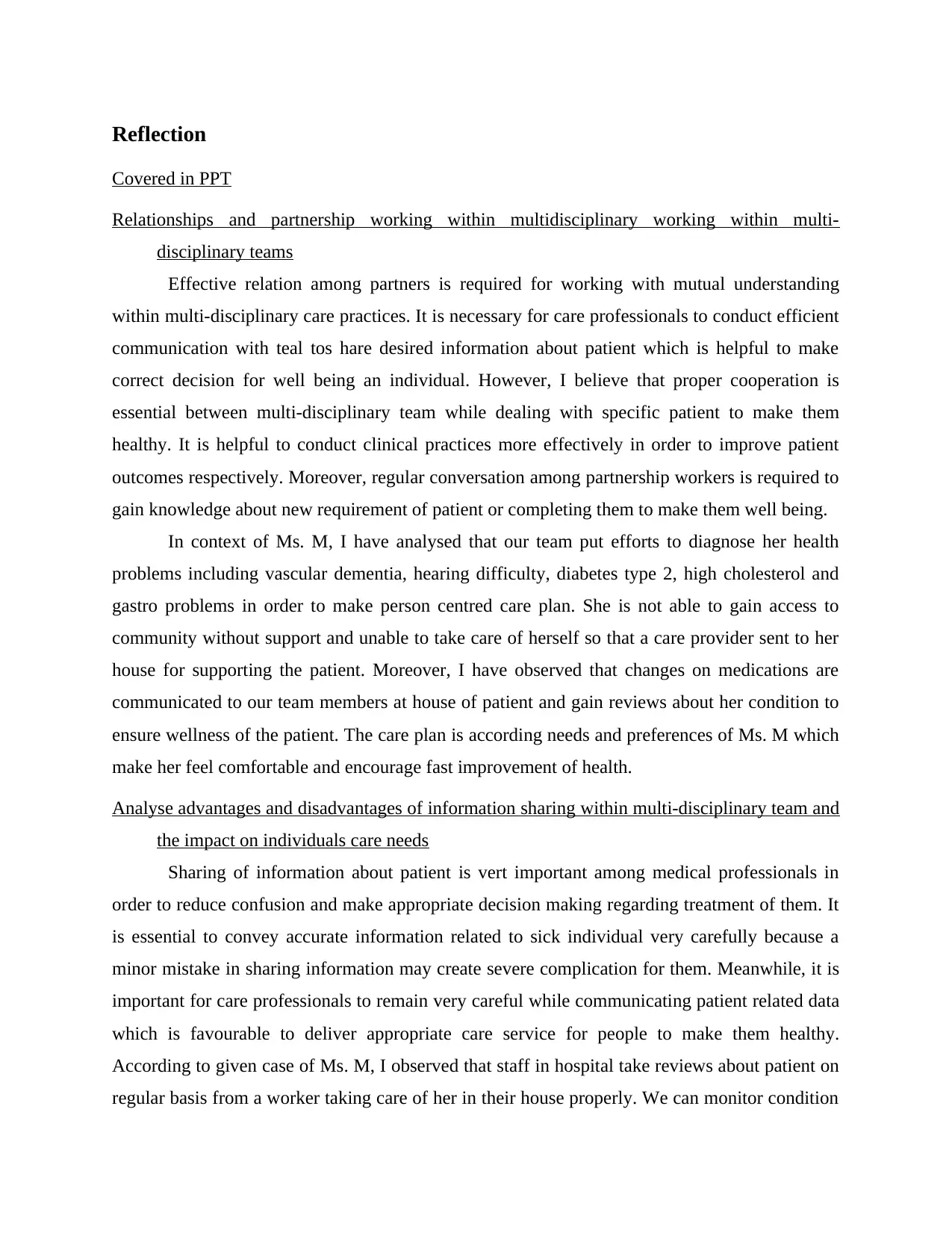
Reflection
Covered in PPT
Relationships and partnership working within multidisciplinary working within multi-
disciplinary teams
Effective relation among partners is required for working with mutual understanding
within multi-disciplinary care practices. It is necessary for care professionals to conduct efficient
communication with teal tos hare desired information about patient which is helpful to make
correct decision for well being an individual. However, I believe that proper cooperation is
essential between multi-disciplinary team while dealing with specific patient to make them
healthy. It is helpful to conduct clinical practices more effectively in order to improve patient
outcomes respectively. Moreover, regular conversation among partnership workers is required to
gain knowledge about new requirement of patient or completing them to make them well being.
In context of Ms. M, I have analysed that our team put efforts to diagnose her health
problems including vascular dementia, hearing difficulty, diabetes type 2, high cholesterol and
gastro problems in order to make person centred care plan. She is not able to gain access to
community without support and unable to take care of herself so that a care provider sent to her
house for supporting the patient. Moreover, I have observed that changes on medications are
communicated to our team members at house of patient and gain reviews about her condition to
ensure wellness of the patient. The care plan is according needs and preferences of Ms. M which
make her feel comfortable and encourage fast improvement of health.
Analyse advantages and disadvantages of information sharing within multi-disciplinary team and
the impact on individuals care needs
Sharing of information about patient is vert important among medical professionals in
order to reduce confusion and make appropriate decision making regarding treatment of them. It
is essential to convey accurate information related to sick individual very carefully because a
minor mistake in sharing information may create severe complication for them. Meanwhile, it is
important for care professionals to remain very careful while communicating patient related data
which is favourable to deliver appropriate care service for people to make them healthy.
According to given case of Ms. M, I observed that staff in hospital take reviews about patient on
regular basis from a worker taking care of her in their house properly. We can monitor condition
Covered in PPT
Relationships and partnership working within multidisciplinary working within multi-
disciplinary teams
Effective relation among partners is required for working with mutual understanding
within multi-disciplinary care practices. It is necessary for care professionals to conduct efficient
communication with teal tos hare desired information about patient which is helpful to make
correct decision for well being an individual. However, I believe that proper cooperation is
essential between multi-disciplinary team while dealing with specific patient to make them
healthy. It is helpful to conduct clinical practices more effectively in order to improve patient
outcomes respectively. Moreover, regular conversation among partnership workers is required to
gain knowledge about new requirement of patient or completing them to make them well being.
In context of Ms. M, I have analysed that our team put efforts to diagnose her health
problems including vascular dementia, hearing difficulty, diabetes type 2, high cholesterol and
gastro problems in order to make person centred care plan. She is not able to gain access to
community without support and unable to take care of herself so that a care provider sent to her
house for supporting the patient. Moreover, I have observed that changes on medications are
communicated to our team members at house of patient and gain reviews about her condition to
ensure wellness of the patient. The care plan is according needs and preferences of Ms. M which
make her feel comfortable and encourage fast improvement of health.
Analyse advantages and disadvantages of information sharing within multi-disciplinary team and
the impact on individuals care needs
Sharing of information about patient is vert important among medical professionals in
order to reduce confusion and make appropriate decision making regarding treatment of them. It
is essential to convey accurate information related to sick individual very carefully because a
minor mistake in sharing information may create severe complication for them. Meanwhile, it is
important for care professionals to remain very careful while communicating patient related data
which is favourable to deliver appropriate care service for people to make them healthy.
According to given case of Ms. M, I observed that staff in hospital take reviews about patient on
regular basis from a worker taking care of her in their house properly. We can monitor condition
Secure Best Marks with AI Grader
Need help grading? Try our AI Grader for instant feedback on your assignments.
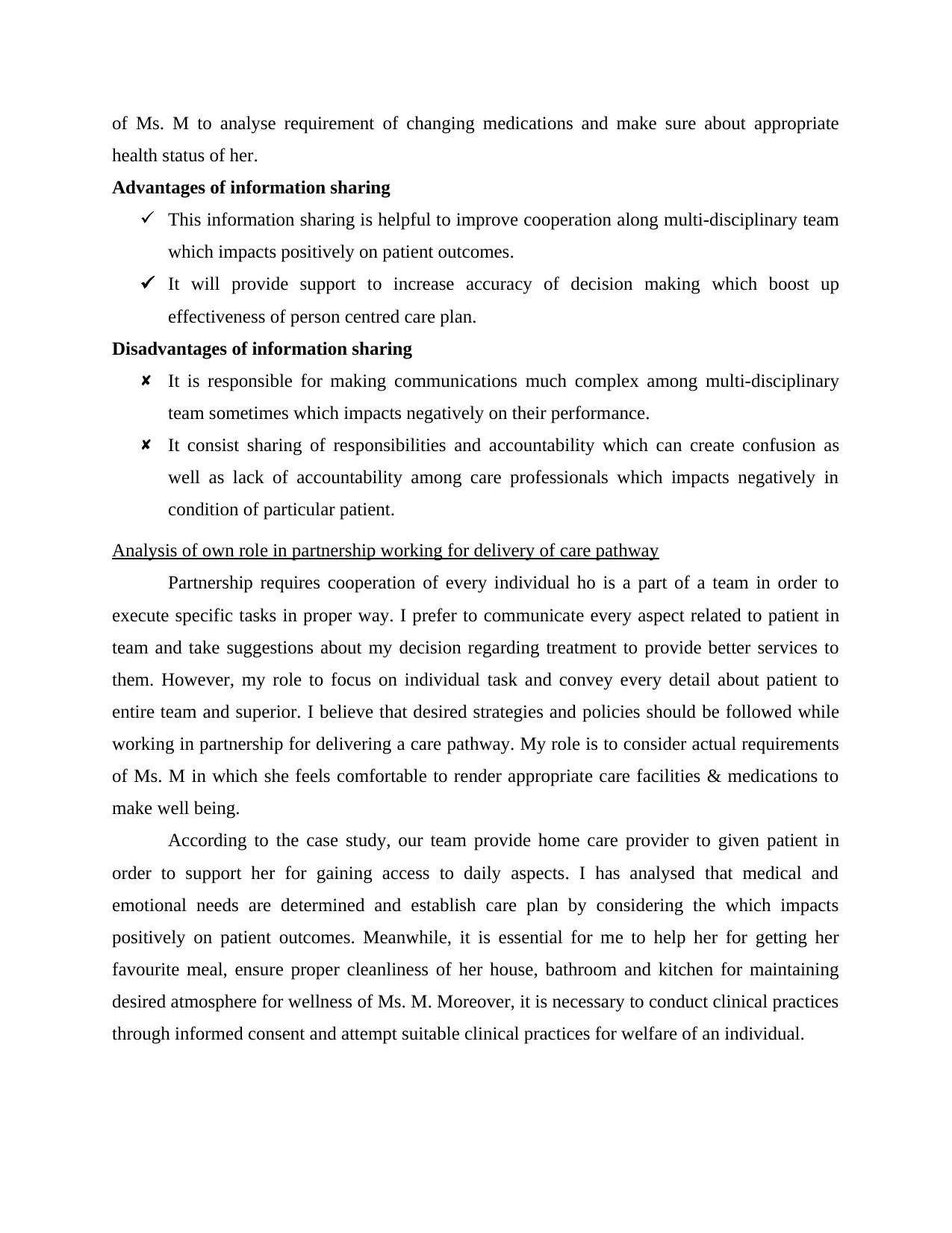
of Ms. M to analyse requirement of changing medications and make sure about appropriate
health status of her.
Advantages of information sharing
This information sharing is helpful to improve cooperation along multi-disciplinary team
which impacts positively on patient outcomes.
It will provide support to increase accuracy of decision making which boost up
effectiveness of person centred care plan.
Disadvantages of information sharing
It is responsible for making communications much complex among multi-disciplinary
team sometimes which impacts negatively on their performance.
It consist sharing of responsibilities and accountability which can create confusion as
well as lack of accountability among care professionals which impacts negatively in
condition of particular patient.
Analysis of own role in partnership working for delivery of care pathway
Partnership requires cooperation of every individual ho is a part of a team in order to
execute specific tasks in proper way. I prefer to communicate every aspect related to patient in
team and take suggestions about my decision regarding treatment to provide better services to
them. However, my role to focus on individual task and convey every detail about patient to
entire team and superior. I believe that desired strategies and policies should be followed while
working in partnership for delivering a care pathway. My role is to consider actual requirements
of Ms. M in which she feels comfortable to render appropriate care facilities & medications to
make well being.
According to the case study, our team provide home care provider to given patient in
order to support her for gaining access to daily aspects. I has analysed that medical and
emotional needs are determined and establish care plan by considering the which impacts
positively on patient outcomes. Meanwhile, it is essential for me to help her for getting her
favourite meal, ensure proper cleanliness of her house, bathroom and kitchen for maintaining
desired atmosphere for wellness of Ms. M. Moreover, it is necessary to conduct clinical practices
through informed consent and attempt suitable clinical practices for welfare of an individual.
health status of her.
Advantages of information sharing
This information sharing is helpful to improve cooperation along multi-disciplinary team
which impacts positively on patient outcomes.
It will provide support to increase accuracy of decision making which boost up
effectiveness of person centred care plan.
Disadvantages of information sharing
It is responsible for making communications much complex among multi-disciplinary
team sometimes which impacts negatively on their performance.
It consist sharing of responsibilities and accountability which can create confusion as
well as lack of accountability among care professionals which impacts negatively in
condition of particular patient.
Analysis of own role in partnership working for delivery of care pathway
Partnership requires cooperation of every individual ho is a part of a team in order to
execute specific tasks in proper way. I prefer to communicate every aspect related to patient in
team and take suggestions about my decision regarding treatment to provide better services to
them. However, my role to focus on individual task and convey every detail about patient to
entire team and superior. I believe that desired strategies and policies should be followed while
working in partnership for delivering a care pathway. My role is to consider actual requirements
of Ms. M in which she feels comfortable to render appropriate care facilities & medications to
make well being.
According to the case study, our team provide home care provider to given patient in
order to support her for gaining access to daily aspects. I has analysed that medical and
emotional needs are determined and establish care plan by considering the which impacts
positively on patient outcomes. Meanwhile, it is essential for me to help her for getting her
favourite meal, ensure proper cleanliness of her house, bathroom and kitchen for maintaining
desired atmosphere for wellness of Ms. M. Moreover, it is necessary to conduct clinical practices
through informed consent and attempt suitable clinical practices for welfare of an individual.
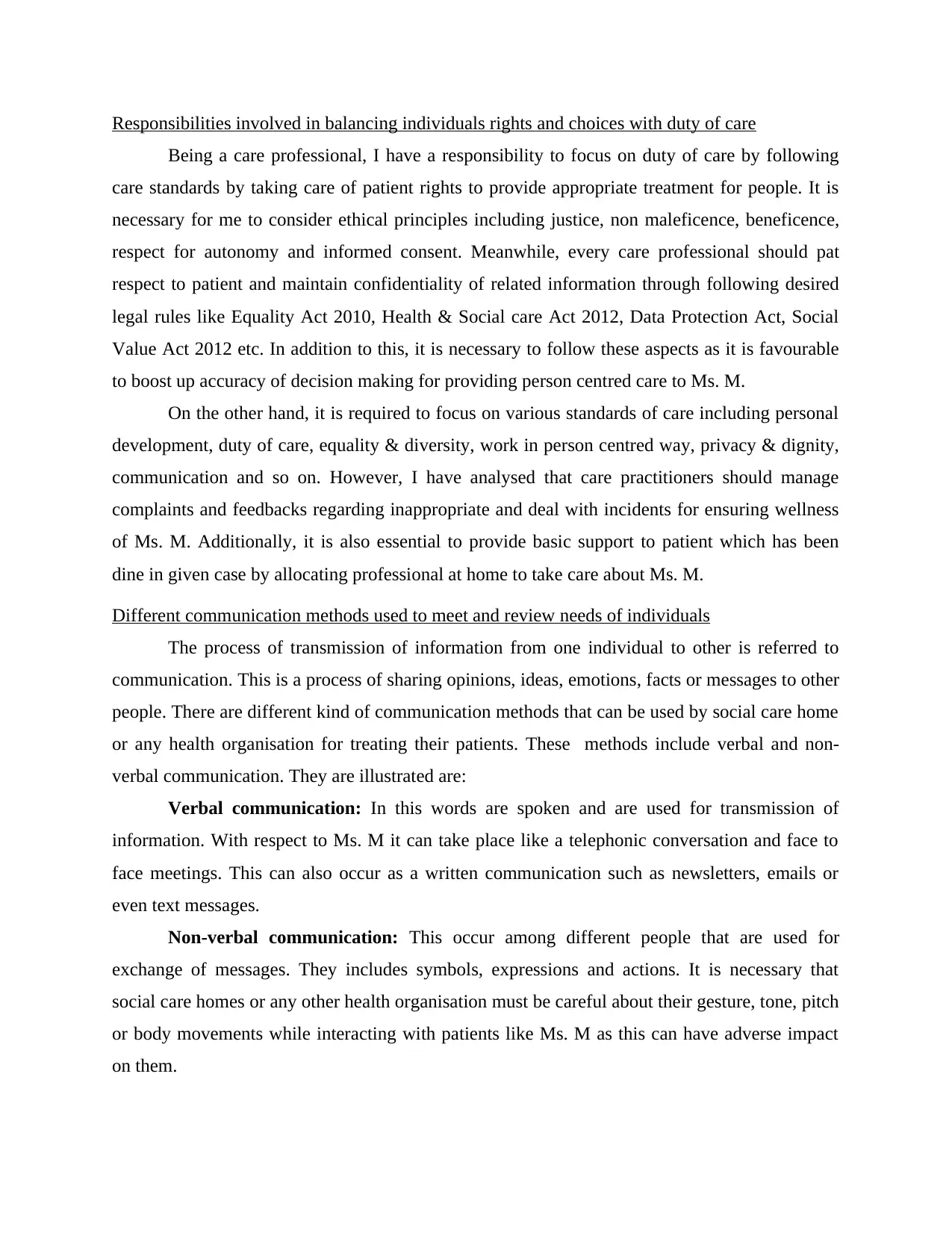
Responsibilities involved in balancing individuals rights and choices with duty of care
Being a care professional, I have a responsibility to focus on duty of care by following
care standards by taking care of patient rights to provide appropriate treatment for people. It is
necessary for me to consider ethical principles including justice, non maleficence, beneficence,
respect for autonomy and informed consent. Meanwhile, every care professional should pat
respect to patient and maintain confidentiality of related information through following desired
legal rules like Equality Act 2010, Health & Social care Act 2012, Data Protection Act, Social
Value Act 2012 etc. In addition to this, it is necessary to follow these aspects as it is favourable
to boost up accuracy of decision making for providing person centred care to Ms. M.
On the other hand, it is required to focus on various standards of care including personal
development, duty of care, equality & diversity, work in person centred way, privacy & dignity,
communication and so on. However, I have analysed that care practitioners should manage
complaints and feedbacks regarding inappropriate and deal with incidents for ensuring wellness
of Ms. M. Additionally, it is also essential to provide basic support to patient which has been
dine in given case by allocating professional at home to take care about Ms. M.
Different communication methods used to meet and review needs of individuals
The process of transmission of information from one individual to other is referred to
communication. This is a process of sharing opinions, ideas, emotions, facts or messages to other
people. There are different kind of communication methods that can be used by social care home
or any health organisation for treating their patients. These methods include verbal and non-
verbal communication. They are illustrated are:
Verbal communication: In this words are spoken and are used for transmission of
information. With respect to Ms. M it can take place like a telephonic conversation and face to
face meetings. This can also occur as a written communication such as newsletters, emails or
even text messages.
Non-verbal communication: This occur among different people that are used for
exchange of messages. They includes symbols, expressions and actions. It is necessary that
social care homes or any other health organisation must be careful about their gesture, tone, pitch
or body movements while interacting with patients like Ms. M as this can have adverse impact
on them.
Being a care professional, I have a responsibility to focus on duty of care by following
care standards by taking care of patient rights to provide appropriate treatment for people. It is
necessary for me to consider ethical principles including justice, non maleficence, beneficence,
respect for autonomy and informed consent. Meanwhile, every care professional should pat
respect to patient and maintain confidentiality of related information through following desired
legal rules like Equality Act 2010, Health & Social care Act 2012, Data Protection Act, Social
Value Act 2012 etc. In addition to this, it is necessary to follow these aspects as it is favourable
to boost up accuracy of decision making for providing person centred care to Ms. M.
On the other hand, it is required to focus on various standards of care including personal
development, duty of care, equality & diversity, work in person centred way, privacy & dignity,
communication and so on. However, I have analysed that care practitioners should manage
complaints and feedbacks regarding inappropriate and deal with incidents for ensuring wellness
of Ms. M. Additionally, it is also essential to provide basic support to patient which has been
dine in given case by allocating professional at home to take care about Ms. M.
Different communication methods used to meet and review needs of individuals
The process of transmission of information from one individual to other is referred to
communication. This is a process of sharing opinions, ideas, emotions, facts or messages to other
people. There are different kind of communication methods that can be used by social care home
or any health organisation for treating their patients. These methods include verbal and non-
verbal communication. They are illustrated are:
Verbal communication: In this words are spoken and are used for transmission of
information. With respect to Ms. M it can take place like a telephonic conversation and face to
face meetings. This can also occur as a written communication such as newsletters, emails or
even text messages.
Non-verbal communication: This occur among different people that are used for
exchange of messages. They includes symbols, expressions and actions. It is necessary that
social care homes or any other health organisation must be careful about their gesture, tone, pitch
or body movements while interacting with patients like Ms. M as this can have adverse impact
on them.
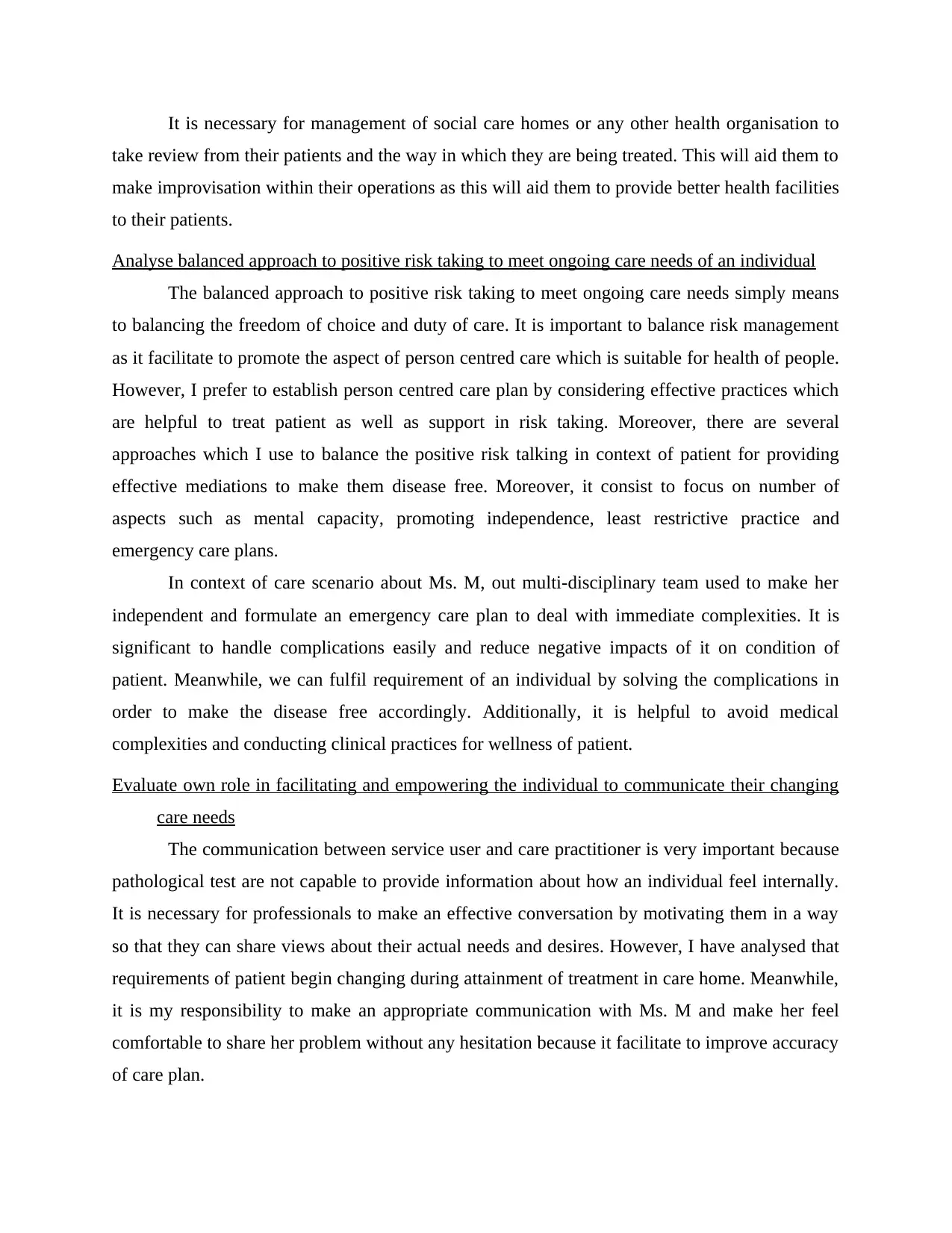
It is necessary for management of social care homes or any other health organisation to
take review from their patients and the way in which they are being treated. This will aid them to
make improvisation within their operations as this will aid them to provide better health facilities
to their patients.
Analyse balanced approach to positive risk taking to meet ongoing care needs of an individual
The balanced approach to positive risk taking to meet ongoing care needs simply means
to balancing the freedom of choice and duty of care. It is important to balance risk management
as it facilitate to promote the aspect of person centred care which is suitable for health of people.
However, I prefer to establish person centred care plan by considering effective practices which
are helpful to treat patient as well as support in risk taking. Moreover, there are several
approaches which I use to balance the positive risk talking in context of patient for providing
effective mediations to make them disease free. Moreover, it consist to focus on number of
aspects such as mental capacity, promoting independence, least restrictive practice and
emergency care plans.
In context of care scenario about Ms. M, out multi-disciplinary team used to make her
independent and formulate an emergency care plan to deal with immediate complexities. It is
significant to handle complications easily and reduce negative impacts of it on condition of
patient. Meanwhile, we can fulfil requirement of an individual by solving the complications in
order to make the disease free accordingly. Additionally, it is helpful to avoid medical
complexities and conducting clinical practices for wellness of patient.
Evaluate own role in facilitating and empowering the individual to communicate their changing
care needs
The communication between service user and care practitioner is very important because
pathological test are not capable to provide information about how an individual feel internally.
It is necessary for professionals to make an effective conversation by motivating them in a way
so that they can share views about their actual needs and desires. However, I have analysed that
requirements of patient begin changing during attainment of treatment in care home. Meanwhile,
it is my responsibility to make an appropriate communication with Ms. M and make her feel
comfortable to share her problem without any hesitation because it facilitate to improve accuracy
of care plan.
take review from their patients and the way in which they are being treated. This will aid them to
make improvisation within their operations as this will aid them to provide better health facilities
to their patients.
Analyse balanced approach to positive risk taking to meet ongoing care needs of an individual
The balanced approach to positive risk taking to meet ongoing care needs simply means
to balancing the freedom of choice and duty of care. It is important to balance risk management
as it facilitate to promote the aspect of person centred care which is suitable for health of people.
However, I prefer to establish person centred care plan by considering effective practices which
are helpful to treat patient as well as support in risk taking. Moreover, there are several
approaches which I use to balance the positive risk talking in context of patient for providing
effective mediations to make them disease free. Moreover, it consist to focus on number of
aspects such as mental capacity, promoting independence, least restrictive practice and
emergency care plans.
In context of care scenario about Ms. M, out multi-disciplinary team used to make her
independent and formulate an emergency care plan to deal with immediate complexities. It is
significant to handle complications easily and reduce negative impacts of it on condition of
patient. Meanwhile, we can fulfil requirement of an individual by solving the complications in
order to make the disease free accordingly. Additionally, it is helpful to avoid medical
complexities and conducting clinical practices for wellness of patient.
Evaluate own role in facilitating and empowering the individual to communicate their changing
care needs
The communication between service user and care practitioner is very important because
pathological test are not capable to provide information about how an individual feel internally.
It is necessary for professionals to make an effective conversation by motivating them in a way
so that they can share views about their actual needs and desires. However, I have analysed that
requirements of patient begin changing during attainment of treatment in care home. Meanwhile,
it is my responsibility to make an appropriate communication with Ms. M and make her feel
comfortable to share her problem without any hesitation because it facilitate to improve accuracy
of care plan.
Paraphrase This Document
Need a fresh take? Get an instant paraphrase of this document with our AI Paraphraser
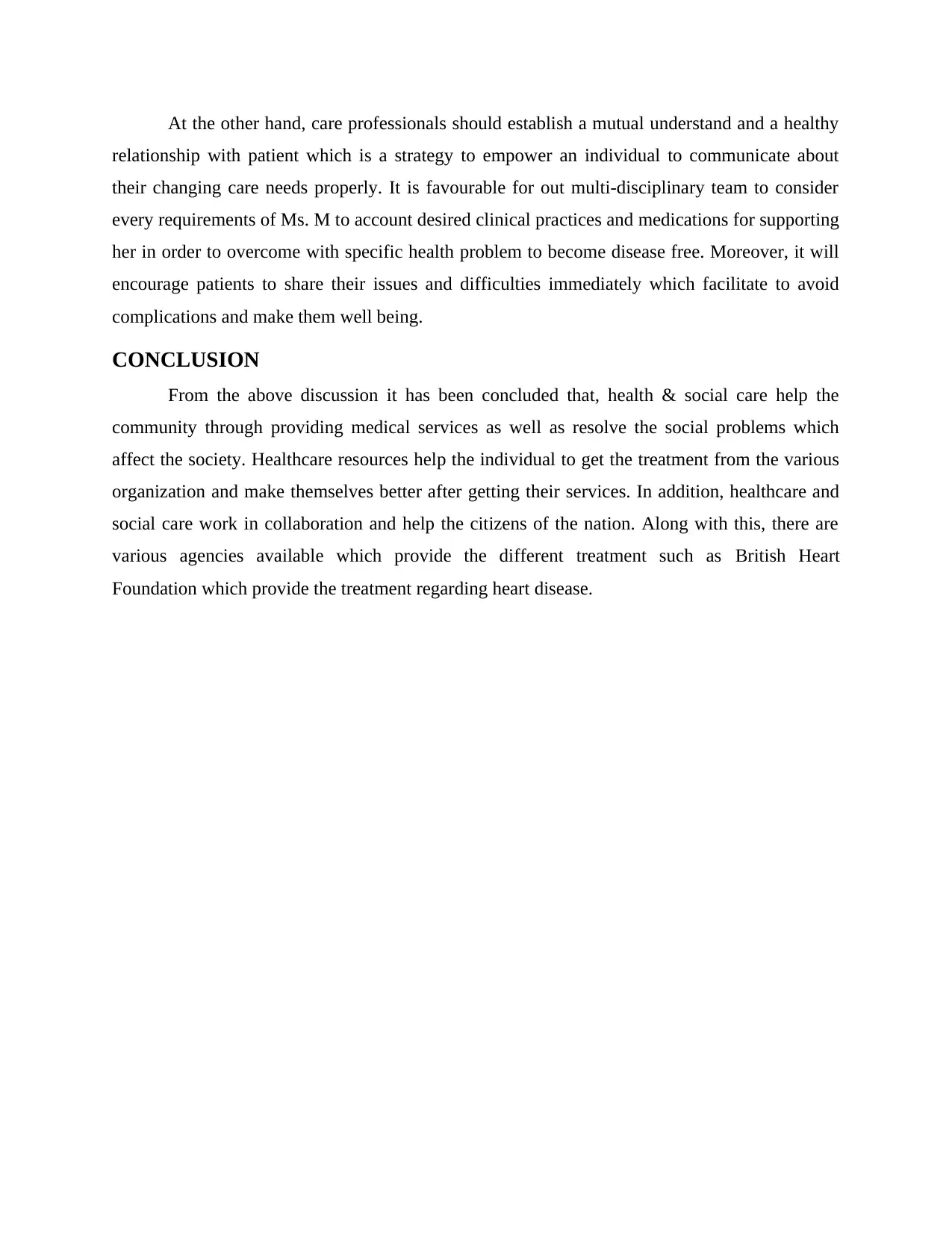
At the other hand, care professionals should establish a mutual understand and a healthy
relationship with patient which is a strategy to empower an individual to communicate about
their changing care needs properly. It is favourable for out multi-disciplinary team to consider
every requirements of Ms. M to account desired clinical practices and medications for supporting
her in order to overcome with specific health problem to become disease free. Moreover, it will
encourage patients to share their issues and difficulties immediately which facilitate to avoid
complications and make them well being.
CONCLUSION
From the above discussion it has been concluded that, health & social care help the
community through providing medical services as well as resolve the social problems which
affect the society. Healthcare resources help the individual to get the treatment from the various
organization and make themselves better after getting their services. In addition, healthcare and
social care work in collaboration and help the citizens of the nation. Along with this, there are
various agencies available which provide the different treatment such as British Heart
Foundation which provide the treatment regarding heart disease.
relationship with patient which is a strategy to empower an individual to communicate about
their changing care needs properly. It is favourable for out multi-disciplinary team to consider
every requirements of Ms. M to account desired clinical practices and medications for supporting
her in order to overcome with specific health problem to become disease free. Moreover, it will
encourage patients to share their issues and difficulties immediately which facilitate to avoid
complications and make them well being.
CONCLUSION
From the above discussion it has been concluded that, health & social care help the
community through providing medical services as well as resolve the social problems which
affect the society. Healthcare resources help the individual to get the treatment from the various
organization and make themselves better after getting their services. In addition, healthcare and
social care work in collaboration and help the citizens of the nation. Along with this, there are
various agencies available which provide the different treatment such as British Heart
Foundation which provide the treatment regarding heart disease.
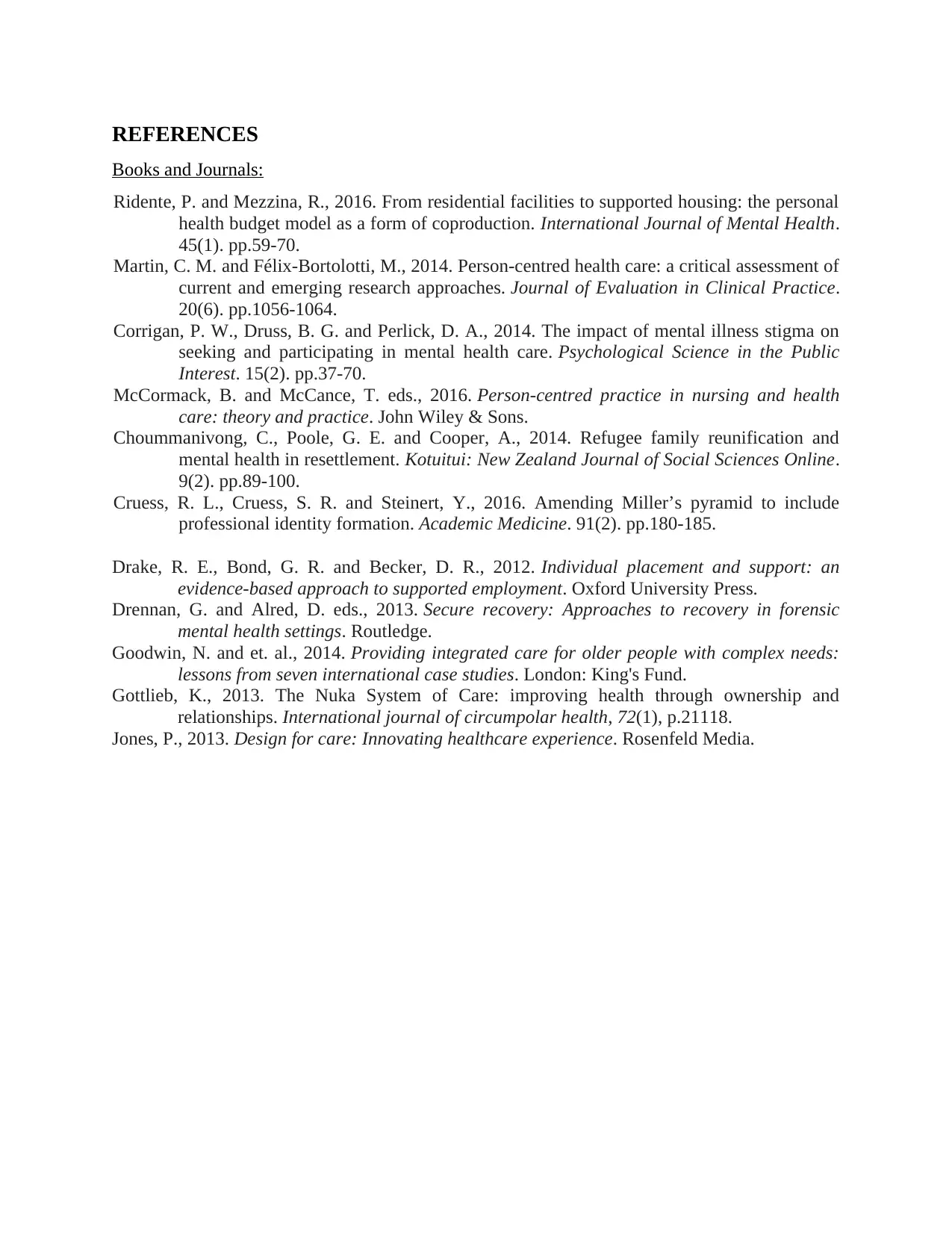
REFERENCES
Books and Journals:
Ridente, P. and Mezzina, R., 2016. From residential facilities to supported housing: the personal
health budget model as a form of coproduction. International Journal of Mental Health.
45(1). pp.59-70.
Martin, C. M. and Félix‐Bortolotti, M., 2014. Person‐centred health care: a critical assessment of
current and emerging research approaches. Journal of Evaluation in Clinical Practice.
20(6). pp.1056-1064.
Corrigan, P. W., Druss, B. G. and Perlick, D. A., 2014. The impact of mental illness stigma on
seeking and participating in mental health care. Psychological Science in the Public
Interest. 15(2). pp.37-70.
McCormack, B. and McCance, T. eds., 2016. Person-centred practice in nursing and health
care: theory and practice. John Wiley & Sons.
Choummanivong, C., Poole, G. E. and Cooper, A., 2014. Refugee family reunification and
mental health in resettlement. Kotuitui: New Zealand Journal of Social Sciences Online.
9(2). pp.89-100.
Cruess, R. L., Cruess, S. R. and Steinert, Y., 2016. Amending Miller’s pyramid to include
professional identity formation. Academic Medicine. 91(2). pp.180-185.
Drake, R. E., Bond, G. R. and Becker, D. R., 2012. Individual placement and support: an
evidence-based approach to supported employment. Oxford University Press.
Drennan, G. and Alred, D. eds., 2013. Secure recovery: Approaches to recovery in forensic
mental health settings. Routledge.
Goodwin, N. and et. al., 2014. Providing integrated care for older people with complex needs:
lessons from seven international case studies. London: King's Fund.
Gottlieb, K., 2013. The Nuka System of Care: improving health through ownership and
relationships. International journal of circumpolar health, 72(1), p.21118.
Jones, P., 2013. Design for care: Innovating healthcare experience. Rosenfeld Media.
Books and Journals:
Ridente, P. and Mezzina, R., 2016. From residential facilities to supported housing: the personal
health budget model as a form of coproduction. International Journal of Mental Health.
45(1). pp.59-70.
Martin, C. M. and Félix‐Bortolotti, M., 2014. Person‐centred health care: a critical assessment of
current and emerging research approaches. Journal of Evaluation in Clinical Practice.
20(6). pp.1056-1064.
Corrigan, P. W., Druss, B. G. and Perlick, D. A., 2014. The impact of mental illness stigma on
seeking and participating in mental health care. Psychological Science in the Public
Interest. 15(2). pp.37-70.
McCormack, B. and McCance, T. eds., 2016. Person-centred practice in nursing and health
care: theory and practice. John Wiley & Sons.
Choummanivong, C., Poole, G. E. and Cooper, A., 2014. Refugee family reunification and
mental health in resettlement. Kotuitui: New Zealand Journal of Social Sciences Online.
9(2). pp.89-100.
Cruess, R. L., Cruess, S. R. and Steinert, Y., 2016. Amending Miller’s pyramid to include
professional identity formation. Academic Medicine. 91(2). pp.180-185.
Drake, R. E., Bond, G. R. and Becker, D. R., 2012. Individual placement and support: an
evidence-based approach to supported employment. Oxford University Press.
Drennan, G. and Alred, D. eds., 2013. Secure recovery: Approaches to recovery in forensic
mental health settings. Routledge.
Goodwin, N. and et. al., 2014. Providing integrated care for older people with complex needs:
lessons from seven international case studies. London: King's Fund.
Gottlieb, K., 2013. The Nuka System of Care: improving health through ownership and
relationships. International journal of circumpolar health, 72(1), p.21118.
Jones, P., 2013. Design for care: Innovating healthcare experience. Rosenfeld Media.
1 out of 15
Related Documents
Your All-in-One AI-Powered Toolkit for Academic Success.
+13062052269
info@desklib.com
Available 24*7 on WhatsApp / Email
![[object Object]](/_next/static/media/star-bottom.7253800d.svg)
Unlock your academic potential
© 2024 | Zucol Services PVT LTD | All rights reserved.





